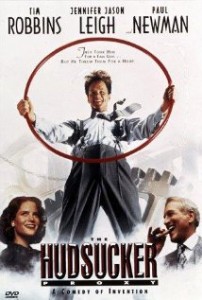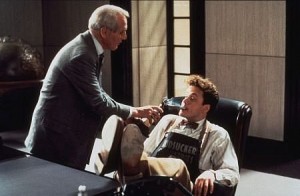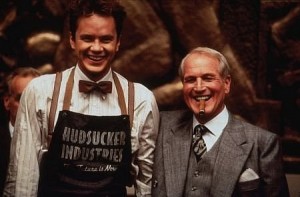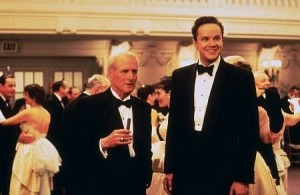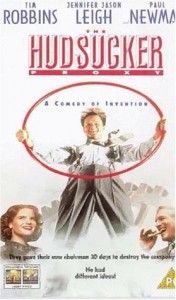The Hudsucker Proxy **** (1994, Tim Robbins, Paul Newman, Jennifer Jason Leigh) – Classic Movie Review 1766
The Coen Brothers’ inspired 1994 satirical screwball comedy about big business and a corporate stock scam is a stunning-looking retro art object, with bravura visuals, witty dialogue, a great score by Carter Burwell and a neat line in wry, cynical humour.
The movie harks back to the style of Thirties golden era Hollywood film comedies, but the story is set in the Fifties. It is the old, famous, archetypal one about an idealistic, innocent hick from the sticks from Muncie, Indiana, confronting the corrupt big city of New York. The Coens are clearly channelling vintage stars Gary Cooper or James Stewart and directors Frank Capra or Preston Sturges.
This time the hick is corporate sucker Norville Barnes (Tim Robbins), a naïve business-school graduate who has just started in the mail room of a huge manufacturing company. But soon he’s being promoted from postman to chairman by the greedy vice-chairman who wants the firm to go bust after the old chairman Waring Hudsucker (Charles Durning), head of hugely successful Hudsucker Industries, unexpectedly commits suicide during a business meeting by jumping out of a top-floor window.
In his first film in four years, the 69-year-old Paul Newman plays the devious head of the board of directors, Sidney J. Mussburger, whose plan it is to appoint a dufus to run the company and sit back and watch while he makes it fail. Mussburger’s idea is that when the stock crashes he can to buy it up for next to nothing and take over the company to restore its fortunes.
Instead, of course, the company prospers after the schmuck invents the Hula Hoop. And then Barnes falls for feisty, fast-talking, Pulitzer Prize-winning star reporter Amy Archer (Jennifer Jason Leigh), who starts sniffing around for the Manhattan Argus and begins an undercover investigation into Hudsucker Industries.
First and foremost, this stylish charmer is an astounding triumph of Roger Deakins’s amazing cinematography, art direction (Leslie MacDonald) and stunning set designs (Tony Fanning) with the technology matching every flight of the Coens’ riotous imagination. The visual effects supervisor is Michael J. McAlister (Indiana Jones and the Last Crusade, Willow) with Mark Stetson (Superman Returns, Peter Pan) as miniatures supervisor.
Perhaps it’s too clever for words, but that makes a welcome change from all the braindead comedies around. It’s left to the actors to bring the human dimension to it and flesh out the stock characters. Robbins makes an attractive, off-centre hero, Leigh is sensational as an appealingly spunky, Katharine Hepburn-style heroine called Amy Archer, and they’ve respectfully made sure that Newman’s got plenty to do in a satisfying star character role as a sympathetic corporate villain.
As usual with Joel Coen and Ethan Coen, this is highly engaging up-market entertainment for smart audiences. Sam Sam Raimi co-wrote the screenplay and served as second unit director, bringing along his regular actor, Bruce Campbell. And Jim True, John Mahoney, John Seitz and Joe Grifasi are also in the cast.
Distributors Warner Bros suggested re-shoots after mixed reactions at test screenings, but the Coens, who had final cut, refused to re-shoot, despite being eager for mainstream success and nervous working with their then biggest budget. However, the film-makers did add some cut footage and shot minor additional footage for the ending. But sadly, after all the good work, The Hudsucker Proxy turned out to be a box office bomb and many critics attacked it.
It premiered in January 1994 at the Sundance Film Festival and was screened at the Cannes Film Festival in May 1994, where it lost the Palme d’Or to Pulp Fiction. It was released on March 11 1994, and grossed only $2,800,000 in the United States. The production budget was set at $25 million, although it was reported to have increased to $40million for marketing and promotion.
The screenplay was finished in 1985, but production only started in 1991 when producer Joel Silver acquired it for his Silver Pictures, with further financing from PolyGram and Working Title. It was filmed at Carolco Studios in Wilmington, North Carolina, between November 1992 and March 1993.
A credit at the end of the movie sets the record straight: ‘The foregoing was a fictional account of the development of the Hula Hoop® and the characters bear no resemblance to any real person or business concern. The Hula Hoop® was actually developed by the founders of the toy company WHAM-O®, a true American success story. WHAM-O® was subsequently responsible for the development of the Frisbee® and numerous other toy products.’ So it wasn’t Tim Robbins, after all. Shame.
The New York City scale model set was designed by Micheal J. McAlister and Mark Stetson, with further effects provided by The Computer Film Company in London.
© Derek Winnert 2014 Classic Movie Review 1766
Check out more reviews on http://derekwinnert.com/

